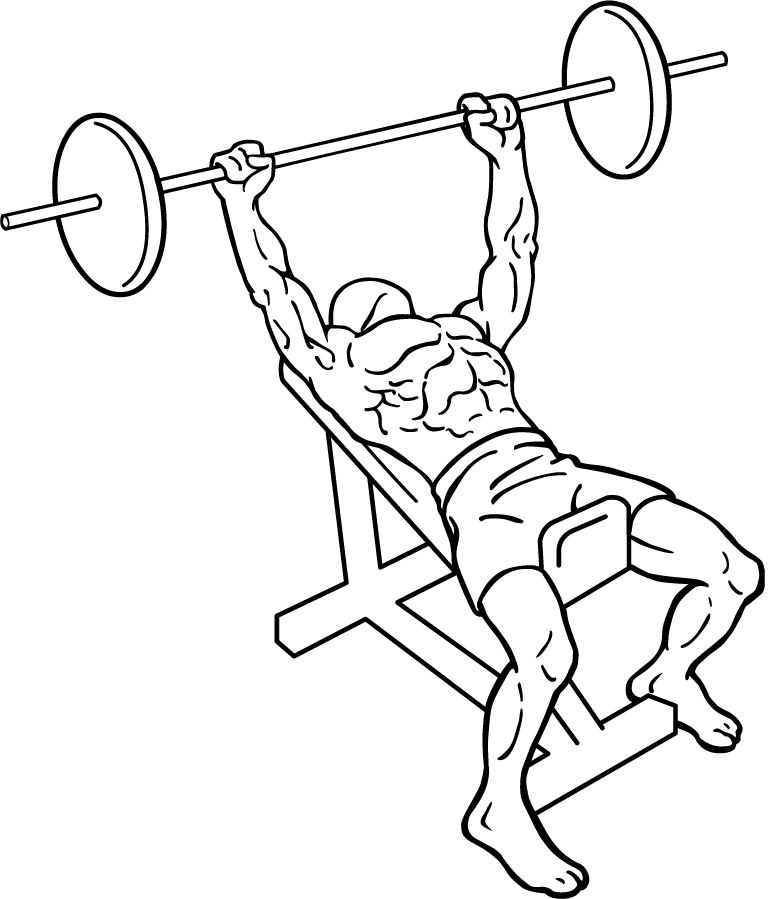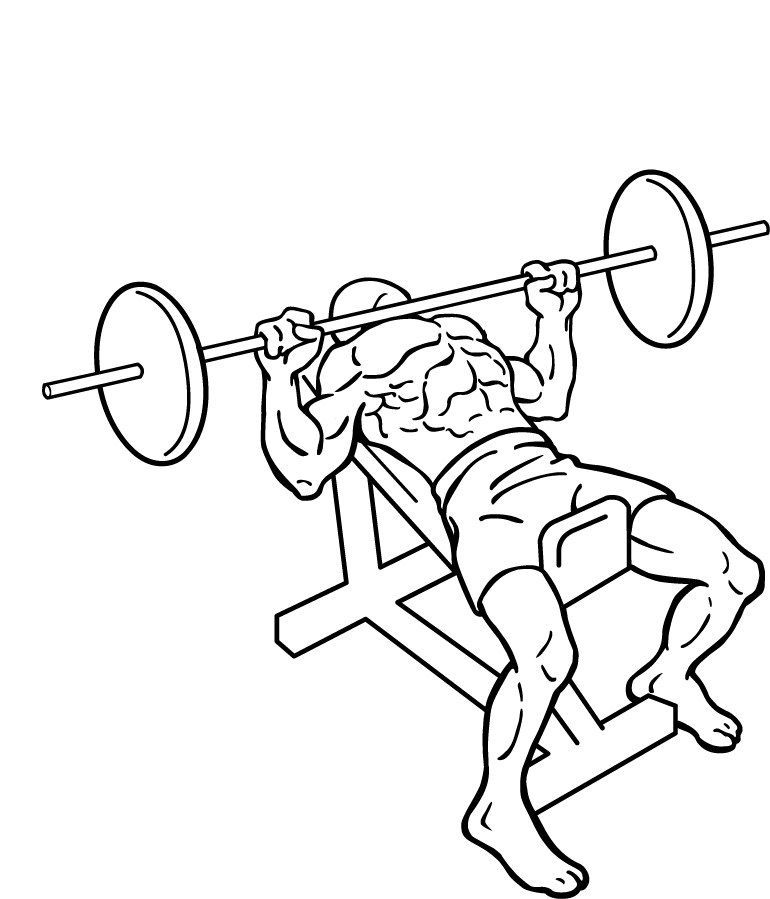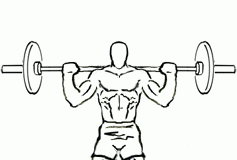Last Updated on September 30, 2022
The Incline Bench Press is a staple exercise for anyone looking to build a strong, well-developed upper body. Targeting the upper chest (pectoralis major), triceps, and front deltoids, this variation of the bench press is key for sculpting a balanced and muscular physique. By changing the angle of the bench, the incline press emphasizes the upper portion of the chest, an area that’s often underdeveloped in standard bench routines. Whether you’re a beginner or an experienced lifter, mastering the incline bench press is essential for building strength and enhancing overall upper body aesthetics.
Why the Incline Bench Press Is Essential
The Incline Bench Press offers several unique benefits that make it a valuable addition to any chest workout routine:
- Targets the Upper Chest: Unlike the traditional bench press, the incline variation shifts the focus to the upper portion of the chest, helping create a fuller, more defined appearance.
- Builds Functional Strength: The incline press involves the chest, triceps, and shoulders, making it an effective compound movement that builds functional strength. This strength is crucial for other pushing movements, enhancing athletic performance.
- Improves Shoulder Stability: The angle of the bench challenges the shoulder stabilizers, promoting strength and stability in the deltoid muscles. Strengthening these smaller muscles reduces the risk of injury in other upper body exercises.
- Enhances Upper Body Aesthetics: Developing the upper chest contributes to a balanced, muscular look, creating a fuller, broader upper body that enhances overall aesthetics and physique.
Step-by-Step Guide to Performing the Incline Bench Press
To ensure you perform the Incline Bench Press safely and effectively, follow these instructions carefully:
- Set Up the Incline Bench:
- Adjust the bench to a 45-degree angle. This angle targets the upper chest optimally while still engaging the triceps and shoulders. Make sure the bench is stable and securely locked into position before starting.
- Position yourself on the bench with your feet flat on the floor, shoulder-width apart. Your feet should provide a strong, stable base, helping you generate power throughout the movement.
- Grip the Bar Correctly:
- Lie back on the bench, making sure your back and shoulders are pressed firmly against the bench. Grasp the barbell with your hands slightly wider than shoulder-width apart. A grip that is too narrow may overly engage the triceps, while a grip too wide can stress the shoulders.
- Ensure your wrists are straight and your palms are facing forward. This grip allows for maximum strength and control during the press.
- Lift the Bar to the Starting Position:
- Unrack the barbell and position it directly above your chest. This is your starting position. Your arms should be fully extended, with your elbows locked out and your chest engaged.
- Engage your core muscles and keep your shoulder blades pulled back to maintain stability and protect your shoulders throughout the movement.
- Lower the Barbell:
- Slowly lower the barbell towards your chest in a controlled manner. The bar should move in a straight line until it just touches your chest. Avoid bouncing the bar off your chest, as this can cause injury and reduces muscle activation.
- Keep your elbows slightly tucked (around a 45-degree angle) to minimize stress on your shoulders and maintain focus on the chest and triceps.
- Press the Barbell Back Up:
- Push the barbell back up to the starting position, fully extending your arms and locking out your elbows. Exhale as you press, using your chest muscles to drive the weight up.
- Make sure the movement is controlled, avoiding any jerking or sudden motions. The bar should travel in a straight line above your chest, ensuring balanced muscle engagement.
- Repeat:
- Perform the desired number of repetitions (typically 8-12 reps per set for muscle hypertrophy). Ensure each rep maintains consistent form to maximize effectiveness and minimize injury risk.
Tips for Optimal Performance
To make the most out of the Incline Bench Press and avoid common mistakes, keep these tips in mind:
- Maintain a Controlled Motion: Avoid rushing through the exercise. Slow and controlled reps ensure maximum engagement of the chest and triceps muscles, leading to better results.
- Engage Your Core: Keep your core tight throughout the movement. A strong core stabilizes your torso, supporting your lower back and maintaining proper alignment during the lift.
- Keep Your Feet Planted: Your feet should remain flat on the floor to provide stability and support. Lifting your feet off the ground reduces balance and increases the risk of injury.
- Avoid Overarching Your Back: It’s normal to have a slight arch in your back, but avoid excessive arching, as this can put stress on your spine. Focus on keeping your back pressed against the bench with a natural, neutral curve.
Common Mistakes and How to Avoid Them
While the Incline Bench Press is effective, several common mistakes can limit its benefits and increase injury risk. Here’s how to avoid them:
- Bouncing the Bar Off the Chest:
- Bouncing the bar reduces muscle engagement and can lead to injury. Always lower the bar in a controlled manner until it lightly touches your chest before pressing it back up.
- Flaring the Elbows Out:
- Allowing your elbows to flare out at a 90-degree angle puts excess stress on your shoulder joints. Instead, keep them at about a 45-degree angle from your torso. This position engages the chest while protecting the shoulders.
- Using Too Much Weight:
- Ego lifting or using excessive weight compromises form and increases injury risk. Start with a manageable weight and focus on mastering the technique before progressing to heavier loads.
- Lifting the Feet Off the Ground:
- Some lifters lift their feet off the floor during the press, which reduces stability. Always keep your feet firmly planted to create a solid base and maximize power output.
Variations and Progressions
To keep your workouts dynamic and continue challenging your muscles, try these variations and progressions:
- Dumbbell Incline Bench Press:
- Using dumbbells instead of a barbell allows for a greater range of motion and engages stabilizer muscles more intensely. This variation also helps correct muscle imbalances between the left and right sides of your chest.
- Incline Bench Press with Bands:
- Adding resistance bands to the barbell increases tension throughout the movement, especially at the top of the lift. This variation is great for building explosive power and increasing muscle engagement.
- Single-Arm Dumbbell Incline Press:
- Pressing one dumbbell at a time engages the core muscles more as they work to stabilize your body. This variation is excellent for improving unilateral strength and balance.
- Incline Close-Grip Bench Press:
- By narrowing your grip on the bar, you shift the emphasis to the triceps. This is an effective variation for lifters looking to build both upper chest and tricep strength simultaneously.
Benefits of the Incline Bench Press
Incorporating the Incline Bench Press into your routine offers several benefits:
- Upper Chest Development: The incline angle targets the upper chest, helping to create a fuller, more balanced look in your upper body.
- Functional Strength: The compound movement of the press builds strength in multiple muscle groups, enhancing functional performance for sports and daily activities.
- Improved Shoulder Stability: The incline position engages the front deltoids, strengthening the shoulder muscles and improving joint stability.
- Versatility: With variations like the dumbbell incline press or close-grip press, you can target different muscle groups and adjust the intensity, keeping your workout routine dynamic and challenging.
Integrating the Incline Bench Press into Your Routine
To maximize the benefits of the Incline Bench Press, integrate it strategically into your workout:
- As a Primary Movement: Place the Incline Bench Press at the beginning of your chest workout when your energy levels are high. This allows you to lift heavier and build strength.
- Superset with Flys: Pair the Incline Bench Press with incline dumbbell flys for a superset that exhausts the chest muscles, promoting hypertrophy and development.
- As a Finisher: Use lighter weights and higher reps (12-15) at the end of your workout for a muscle pump, enhancing blood flow and recovery.
Frequently Asked Questions
1. How many sets and reps should I perform for the Incline Bench Press?
- For muscle growth, aim for 3-4 sets of 8-12 reps with moderate to heavy weight. For strength, perform 4-5 sets of 4-6 reps with a heavier load.
2. Is the Incline Bench Press safe for beginners?
- Yes, beginners can perform the Incline Bench Press, but they should start with lighter weights and focus on mastering the form. It’s also recommended to have a spotter for added safety.
3. Can I perform the Incline Bench Press at home?
- If you have access to an adjustable bench and a barbell or dumbbells, you can perform this exercise at home. Make sure your setup is stable to avoid any accidents.
Final Tips for Success
- Warm Up Thoroughly: Before performing the Incline Bench Press, ensure you warm up your chest, shoulders, and triceps with dynamic stretches and lighter weight movements like push-ups or shoulder circles. This reduces the risk of injury and prepares the muscles for the heavier load.
- Focus on Technique Over Weight: Prioritize perfect form over lifting heavy. Proper technique will engage the right muscles and prevent injuries, allowing for long-term progress and strength development.
- Incorporate Variety: To continually challenge your muscles and prevent plateaus, incorporate different variations like dumbbell incline presses, or adjust the bench angle slightly (30-60 degrees) to engage different parts of your chest.
Building a Routine Around the Incline Bench Press
Integrating the Incline Bench Press effectively into your workout depends on your goals:
- For Muscle Growth and Hypertrophy: Perform the Incline Bench Press as a primary movement on your chest day with 3-4 sets of 8-12 reps, followed by accessory exercises like chest flys, dips, or cable crossovers to maximize muscle engagement.
- For Strength Development: Focus on heavier weights with 4-5 sets of 4-6 reps, incorporating progressive overload by gradually increasing the weight while maintaining good form. Pair this with lower rep compound movements like flat bench press and overhead press for a comprehensive upper body routine.
- For Functional Fitness: Combine the Incline Bench Press with bodyweight exercises and stability drills, such as push-ups on a stability ball or TRX chest presses. This combination builds both strength and functional capacity.
Conclusion
The Incline Bench Press is more than just a strength exercise—it’s a crucial movement for sculpting the upper chest and enhancing overall upper body stability. Whether you’re aiming to build muscle, improve functional fitness, or achieve a balanced and powerful physique, mastering the Incline Bench Press is essential.
With consistent practice, attention to form, and strategic progression, you can maximize the benefits of this exercise, building strength and aesthetics simultaneously. Remember to adjust your grip, bench angle, and weight as you advance, keeping your workouts varied and challenging.
By integrating the Incline Bench Press into your training program with the tips and techniques outlined here, you’ll see significant improvements in your upper body development, ultimately helping you achieve your fitness goals one press at a time.








